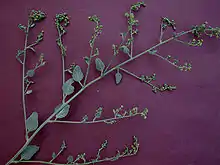Dicoria canescens
Dicoria canescens is a North American flowering plant in the family Asteraceae known by several common names including desert twinbugs and bugseed.[2][3] This is a desert plant of the southwestern United States and northwestern Mexico, found in Sonora, Baja California, southern California, Nevada, Arizona, Utah, southwestern Colorado, and northwestern New Mexico.[3][4][5]
| Dicoria canescens | |
|---|---|
 | |
| Scientific classification | |
| Kingdom: | Plantae |
| Clade: | Tracheophytes |
| Clade: | Angiosperms |
| Clade: | Eudicots |
| Clade: | Asterids |
| Order: | Asterales |
| Family: | Asteraceae |
| Genus: | Dicoria |
| Species: | D. canescens |
| Binomial name | |
| Dicoria canescens | |
| Synonyms[1] | |
| |
Dicoria canescens forms thickets of many individuals in the desert sand. The distinctive lower leaves are long, pointed, sharply toothed, and covered in a coat of thin white or gray hairs. The upper leaves are smaller and more rounded. One plant can produce several whitish flower heads containing disc florets but no ray florets. Sometimes the heads form closely associated pairs, a characteristic which is the origin of the common name "twinbugs".[6][7][8][9]
References
- The Plant List, Dicoria canescens A.Gray
- Philip A. Munz; Diane L. Renshaw; Phyllis M. Faber (2004). Introduction to California Desert Wildflowers. University of California Press. p. 235. ISBN 0-520-23632-7. page 118
- Calflora taxon report, University of California, Dicoria canescens A. Gray, desert twinbugs
- Biota of North America Program 2014 county distribution map
- Shreve, F. & I. L. Wiggins. 1964. Vegetation and Flora of the Sonoran Desert 2 vols. Stanford University Press, Stanford.
- Flora of North America, Dicoria canescens A. Gray in W. H. Emory
- Gray, Asa 1859. in Emory, William Hemsley, Report on the United States and Mexican boundary survey made under the direction of the secretary of the Interior 2(1): page 87 description and commentary in English
- Gray, Asa 1859. in Emory, William Hemsley, Report on the United States and Mexican boundary survey made under the direction of the secretary of the Interior 2(1): plate 30 full-page line drawing of Dicoria canescens
- SEINEt, Southwest Biodiversity, Arizona Chapter, Dicoria canescens A. Gray, desert twinbugs photos, description in English, distribution map
